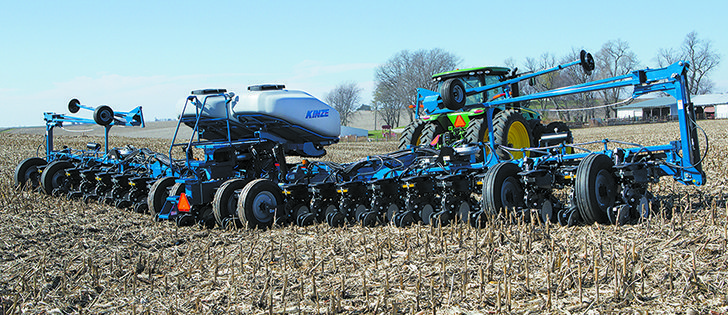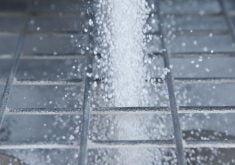Faster and accurate | New planters cover more ground but keep precision
Not to be outdone by two new high-speed European imports, the American Kinze plans to introduce a new planter for 2014.
Increasing farm size and rising income has fuelled demand for planters capable of working at double speed while maintaining 99 percent accuracy.
In recent months, Seed Hawk introduced their new Tempo planter from Sweden and Horsch Anderson their Maestro, both with leading edge European technology.
Not to be outdone, Kinze expects to soon have its 2014 model 4900 planter available. The 24-row version carries 120 bushels of seed along with 500 gallons of liquid fertilizer and delivers 99 percent seed placement accuracy at speeds up to eight m.p.h.
Read Also

Saskatchewan project sees intercrop, cover crop benefit
An Indigenous-led Living Lab has been researching regenerative techniques is encouraging producers to consider incorporating intercrops and cover crops with their rotations.
This is due to a new vacuum metering system that has been five years in development, according to Kinze’s Rhett Schildroth.
Will the Kinze 4900 ground speed of eight m.p.h. compete favourably in the sales arena against the Maestro and Tempo, both of which are touted as capable of planting corn with 99 percent accuracy at 10 m.p.h.?
Schildroth feels the slightly slower ground speed is not an issue for Kinze. He says growers with higher speed planters will figure out that 10 m.p.h. is too fast for good seed placement. He thinks they will probably end up planting at eight.
“The speed of a planter is still limited by the ability to keep the row unit at the same depth in the soil,” explains Schildroth.
He says in the past, metering systems have kept planters in the range of five m.p.h. or slower. At higher speeds, the meters could not provide good singulation.
“The 4000 series meter is no longer a limiting factor. But perfect seed placement still requires the row unit to run smoothly at a constant depth.
“We think eight m.p.h. is the maximum speed you can run before you start to get row unit bounce. If you expect the best seed placement and most uniform emergence, you cannot tolerate any row unit bounce.”
Kinze has two different systems for controlling down force and bounce. Their traditional spring system is still available, but a pneumatic option has been introduced and is catching on, in part because it’s adjustable on the go, from the cab.
“The pneumatic system gives the row units a smoother ride. There’s far less bounce, so you have more consistent seed depth down the row and that gives you more uniform emergence.
“Surprisingly, the spring system responds faster than the pneumatic, but the spring system overshoots all the time. When it goes up, it goes too far up. When it goes down, it goes too far down.
“The pneumatic system doesn’t overcompensate like that.”
Schildroth says the electric drive metering system is another new feature contributing to better seed placement. Already common on European corn planters, he says North American growers like the electric drive idea.
“It’s 24 volt, so it produces plenty of torque. Growers like it because it eliminates that long shaft across the planter. There are no chains and no electric or air clutches.”
He says the operator can control the population in each row individually. For example, in a field with contours or wide radius sweeping turns, the outside row travels a greater distance than the inside row, and the system adjusts the rates across the machine. The same system eliminates overlap in the headlands.
An integral component of accurate seed metering is the small microprocessor located at the seed sensor, where it can count each seed. That data is fed to the controller.
“It’s not quite as important in low population crops like corn. But high population crops like soybeans will saturate a counting system.
“When the processor becomes overwhelmed with data, it does the only thing it knows how. It starts averaging seed numbers. And when that happens, your precision is gone. You can’t average and be precise at the same time.
“But now, with a microprocessor installed at each sensor, we can account for every seed, even soybean seeds. Plus, we now have higher resolution that differentiates between seed and dust. That also makes it more accurate.”
The two new European planters coming to North America use air pressure instead of vacuum to hold the seed in the exact position on the metering disc. Kinze decided to stay with vacuum force.
“We found it’s more difficult to get the seed applied to the plate accurately when you blow air on the same side of the plate the seed is on,” says Schildroth.
“It’s easier to get accuracy at high speed in a vacuum system with the seed on one side of the disc and negative air pressure on the other side, pulling the seed into position.”
With the ability to carry 120 bushels of seed along with 500 gallons of start-up liquid on the 24-row centre section, Kinze engineers wanted to make sure the machine did not create compaction issues or have the centre section sink in muddy fields. To do it they hydraulically transfer weight from the heavier centre section out to the wings.
“If we wanted, we could actually transfer enough weight to the wings to lift the centre section of the 4900 off the ground,” he said.
Manoeuvrability is a problem with large, 24-row, front-fold corn planters because of the long wheelbase in transport mode.
Many growers have been forced to fill in ditches or build new approaches to get the machine into the field.
A short wheelbase turns tighter, so Kinze engineers put a short transport wheelbase under their 24-row planter.
To cut about five feet out of it, they created a novel flip axle that rotates forward on its own pivot. A hydraulic cylinder lifts the planter so it goes over-centre and comes back down again.
Kinze offers the hydraulic transmission drive, ground contact transmission drive and the new electric transmission drive. The first production runs will be built with the electric drive only.
“In the future, the electric drive transmission will totally displace hydraulic drive.
“We’ve kept the ground contact transmission. We have a lot of repeat buyers who buy Kinze because of the simplicity. Those are the guys who we figured would still want the old ground contact system.”
However electric appears to be the preference of growers, he said.
While a canola disc is in development, so far the 4900 can handle seed for corn, sugar beet, soybean and milo.
“And here’s an odd request. We have some wheat growers down here who have been seeding wheat through their Kinze planters. They want us to work with them on that project. So we’re starting to look into a disc for wheat.”
The first run of 4900 planters will consist of 12-row, 16-row and 24-row units.
Despite the trend toward upsizing equipment, Schildroth says a strong market for 12-row planters remains, mainly among farmers upgrading from eight-row units.
















